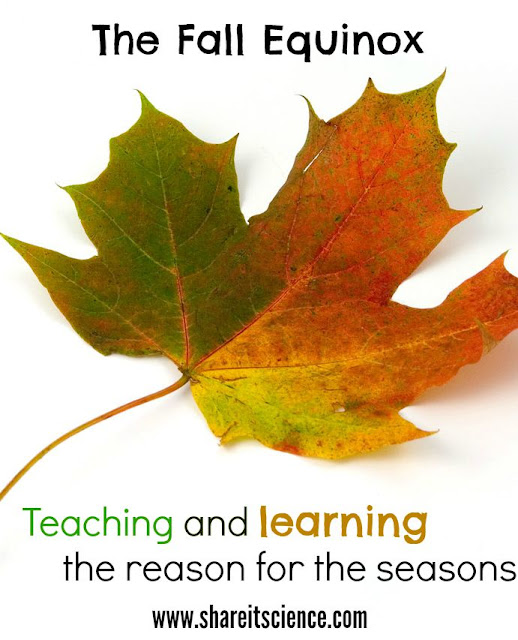Happy Autumnal Equinox! Autumna-wha?
More on that later, just know that September 22nd is the official beginning of the
fall season! In this post you'll find some great resources for explaining the changing seasons to kids, and some pitfalls to avoid.
If you live where the leaves change color you might be seeing some of that happening, and you may be somewhere where the temperature is cooling. What other signs have you experienced as the seasons change? Migrations, plants dying back, fuzzy caterpillars, apples, etc. etc. The days begin to get shorter, with a little less daylight each day...ahhh, now we're getting somewhere.
Why do the seasons change?
Do you know what causes the changing seasons? I'll give you a second to think about it.... Got it?
Did you say the seasons change as Earth moves closer and further from the sun? How good do you feel about that answer?
Hate to tell you, but that is
incorrect. The good news is- you are not alone. This is probably one
of the most pervasive science misconceptions we face. Just remember
this- it's all about that tilt.
This post contains affiliate links, please see disclosures for more information.
This post contains affiliate links, please see disclosures for more information.
Science Misconceptions
For those of us who have taken a
science teaching methods course, this is probably a familiar topic.
An interesting video that was made quite a while back called, A Private Universe,
explores these misconceptions. In what is now a
well-known opening scene, Harvard students on their graduation day
are asked what causes the Earth to have seasons. Although you have to
purchase this video to
see it in its entirety, here is a snippet.
You quickly begin to see that
regardless of a high quality education, science misconceptions lurk!
[If you are a teacher, I'd recommend
getting your hands on this video. Despite being a bit dated (if you
haven't seen anyone dressed like this in real life then you must be younger than me!) the problem still rings true today. Misconceptions are
hard to break, even after evidence has been presented otherwise.]

Why Do We Experience Seasons on Earth?
Harvard students take note: It's all
about that tilt. The Earth rotates on its own axis as it revolves around the sun. Imagine the Earth is a cherry tomato and we put a
skewer through the center. The skewer is the Earth's axis. This axis does not
stand perfectly upright, it leans to one side. (Scientists believe at
some point we were hit with something big that knocked us off
kilter.) Now, maintaining your angle of axis, revolve your skewered
tomato around the "sun"- a basketball perhaps. Is the same
part of the tomato leaning towards the sun?
As the planet revolves around the sun, in what is almost a perfectly circular orbit, there are points of time when the Northern hemisphere receives more direct sunlight than the Southern hemisphere. At this time of the year, the Northern hemisphere is experiencing summer, the Southern hemisphere is experiencing winter, and vice versa. For a great graphic illustrating this concept visit NASA's Space Place page on seasons.
You also won't want to miss these 20 must-try science experiments for fall!
 |
| by-woodleywonderworks Flickr Creative Commons |
The Autumnal Equinox
As the planet revolves around the sun, in what is almost a perfectly circular orbit, there are points of time when the Northern hemisphere receives more direct sunlight than the Southern hemisphere. At this time of the year, the Northern hemisphere is experiencing summer, the Southern hemisphere is experiencing winter, and vice versa. For a great graphic illustrating this concept visit NASA's Space Place page on seasons.
Ok, so what about that whole "Autumnal
Equinox" thing? There are 2 points in the year when the
hemispheres receive equal amounts of sunlight because for just a
short period of time the Earth is "upright" rather than
tilted, in relation to the sun. Today we will have the equal amounts
of daylight and night time- about 12 hours each. You may have noticed
equal and equinox share the root- equ meaning similar.
The second equinox is in the springtime, or the Vernal Equinox.
Below are some resources and activities
to help students understand the seasons better, beyond the seasonal changes we
can observe in nature. Pop Quiz: What are you going to
remember? Yup, it's all about that tilt. (See? You could have gone to
Harvard too!)
Resources for Teaching and Learning About the Seasons:
- Where is the Sun? Model the changing position of the sun with simple materials
- Dress for the Weather- Preschool level digital interactive for learning 4 seasons
- Kinesthetic Astronomy Lesson- Middle Grades
- Annenberg Learner Resources: A Private Universe
If you are teaching or studying about changes that happen in the autumn, you'll want to try this science experiment that helps us understand why the leaves change color.
You also won't want to miss these 20 must-try science experiments for fall!



No comments:
New comments are not allowed.